Zhuoshi Pan
Middo: Model-Informed Dynamic Data Optimization for Enhanced LLM Fine-Tuning via Closed-Loop Learning
Aug 29, 2025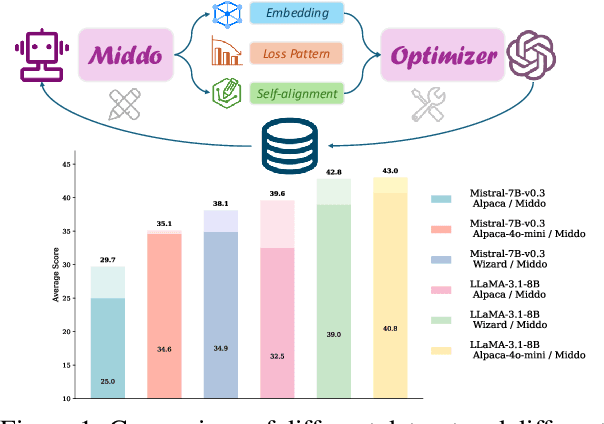
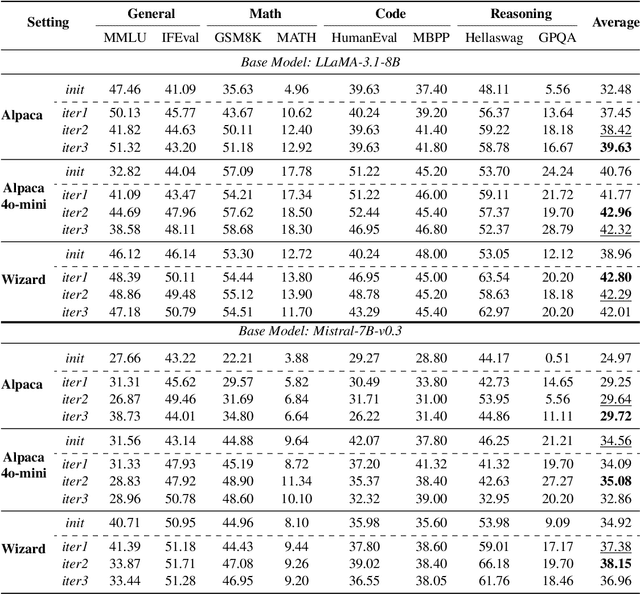
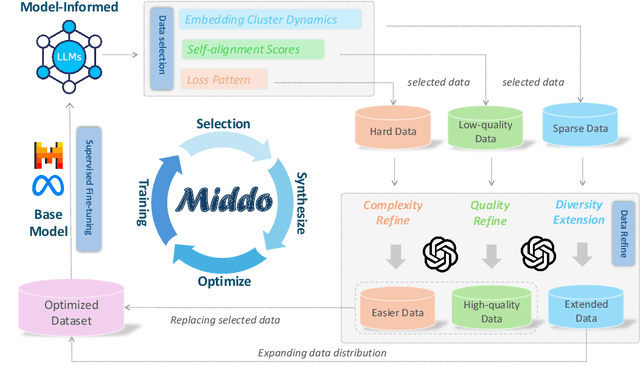
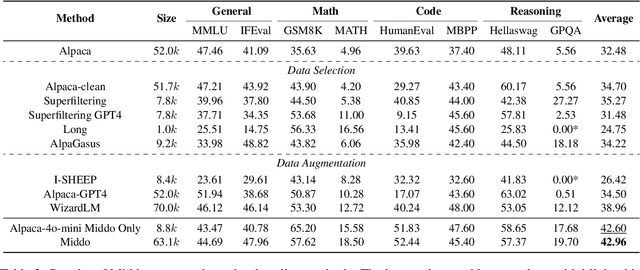
Abstract:Supervised Fine-Tuning (SFT) Large Language Models (LLM) fundamentally rely on high-quality training data. While data selection and data synthesis are two common strategies to improve data quality, existing approaches often face limitations in static dataset curation that fail to adapt to evolving model capabilities. In this paper, we introduce Middo, a self-evolving Model-informed dynamic data optimization framework that uses model-aware data selection and context-preserving data refinement. Unlike conventional one-off filtering/synthesis methods, our framework establishes a closed-loop optimization system: (1) A self-referential diagnostic module proactively identifies suboptimal samples through tri-axial model signals - loss patterns (complexity), embedding cluster dynamics (diversity), and self-alignment scores (quality); (2) An adaptive optimization engine then transforms suboptimal samples into pedagogically valuable training points while preserving semantic integrity; (3) This optimization process continuously evolves with model capability through dynamic learning principles. Experiments on multiple benchmarks demonstrate that our \method consistently enhances the quality of seed data and boosts LLM's performance with improving accuracy by 7.15% on average while maintaining the original dataset scale. This work establishes a new paradigm for sustainable LLM training through dynamic human-AI co-evolution of data and models. Our datasets, models, and code are coming soon.
Can One Domain Help Others? A Data-Centric Study on Multi-Domain Reasoning via Reinforcement Learning
Jul 23, 2025Abstract:Reinforcement Learning with Verifiable Rewards (RLVR) has emerged as a powerful paradigm for enhancing the reasoning capabilities of LLMs. Existing research has predominantly concentrated on isolated reasoning domains such as mathematical problem-solving, coding tasks, or logical reasoning. However, real world reasoning scenarios inherently demand an integrated application of multiple cognitive skills. Despite this, the interplay among these reasoning skills under reinforcement learning remains poorly understood. To bridge this gap, we present a systematic investigation of multi-domain reasoning within the RLVR framework, explicitly focusing on three primary domains: mathematical reasoning, code generation, and logical puzzle solving. We conduct a comprehensive study comprising four key components: (1) Leveraging the GRPO algorithm and the Qwen-2.5-7B model family, our study thoroughly evaluates the models' in-domain improvements and cross-domain generalization capabilities when trained on single-domain datasets. (2) Additionally, we examine the intricate interactions including mutual enhancements and conflicts that emerge during combined cross-domain training. (3) To further understand the influence of SFT on RL, we also analyze and compare performance differences between base and instruct models under identical RL configurations. (4) Furthermore, we delve into critical RL training details, systematically exploring the impacts of curriculum learning strategies, variations in reward design, and language-specific factors. Through extensive experiments, our results offer significant insights into the dynamics governing domain interactions, revealing key factors influencing both specialized and generalizable reasoning performance. These findings provide valuable guidance for optimizing RL methodologies to foster comprehensive, multi-domain reasoning capabilities in LLMs.
InvestAlign: Overcoming Data Scarcity in Aligning Large Language Models with Investor Decision-Making Processes under Herd Behavior
Jul 09, 2025Abstract:Aligning Large Language Models (LLMs) with investor decision-making processes under herd behavior is a critical challenge in behavioral finance, which grapples with a fundamental limitation: the scarcity of real-user data needed for Supervised Fine-Tuning (SFT). While SFT can bridge the gap between LLM outputs and human behavioral patterns, its reliance on massive authentic data imposes substantial collection costs and privacy risks. We propose InvestAlign, a novel framework that constructs high-quality SFT datasets by leveraging theoretical solutions to similar and simple optimal investment problems rather than complex scenarios. Our theoretical analysis demonstrates that training LLMs with InvestAlign-generated data achieves faster parameter convergence than using real-user data, suggesting superior learning efficiency. Furthermore, we develop InvestAgent, an LLM agent fine-tuned with InvestAlign, which demonstrates significantly closer alignment to real-user data than pre-SFT models in both simple and complex investment problems. This highlights our proposed InvestAlign as a promising approach with the potential to address complex optimal investment problems and align LLMs with investor decision-making processes under herd behavior. Our code is publicly available at https://github.com/thu-social-network-research-group/InvestAlign.
Lightweight Transformer via Unrolling of Mixed Graph Algorithms for Traffic Forecast
May 19, 2025



Abstract:To forecast traffic with both spatial and temporal dimensions, we unroll a mixed-graph-based optimization algorithm into a lightweight and interpretable transformer-like neural net. Specifically, we construct two graphs: an undirected graph $\mathcal{G}^u$ capturing spatial correlations across geography, and a directed graph $\mathcal{G}^d$ capturing sequential relationships over time. We formulate a prediction problem for the future samples of signal $\mathbf{x}$, assuming it is "smooth" with respect to both $\mathcal{G}^u$ and $\mathcal{G}^d$, where we design new $\ell_2$ and $\ell_1$-norm variational terms to quantify and promote signal smoothness (low-frequency reconstruction) on a directed graph. We construct an iterative algorithm based on alternating direction method of multipliers (ADMM), and unroll it into a feed-forward network for data-driven parameter learning. We insert graph learning modules for $\mathcal{G}^u$ and $\mathcal{G}^d$, which are akin to the self-attention mechanism in classical transformers. Experiments show that our unrolled networks achieve competitive traffic forecast performance as state-of-the-art prediction schemes, while reducing parameter counts drastically. Our code is available in https://github.com/SingularityUndefined/Unrolling-GSP-STForecast.
IDEAL: Data Equilibrium Adaptation for Multi-Capability Language Model Alignment
May 19, 2025



Abstract:Large Language Models (LLMs) have achieved impressive performance through Supervised Fine-tuning (SFT) on diverse instructional datasets. When training on multiple capabilities simultaneously, the mixture training dataset, governed by volumes of data from different domains, is a critical factor that directly impacts the final model's performance. Unlike many studies that focus on enhancing the quality of training datasets through data selection methods, few works explore the intricate relationship between the compositional quantity of mixture training datasets and the emergent capabilities of LLMs. Given the availability of a high-quality multi-domain training dataset, understanding the impact of data from each domain on the model's overall capabilities is crucial for preparing SFT data and training a well-balanced model that performs effectively across diverse domains. In this work, we introduce IDEAL, an innovative data equilibrium adaptation framework designed to effectively optimize volumes of data from different domains within mixture SFT datasets, thereby enhancing the model's alignment and performance across multiple capabilities. IDEAL employs a gradient-based approach to iteratively refine the training data distribution, dynamically adjusting the volumes of domain-specific data based on their impact on downstream task performance. By leveraging this adaptive mechanism, IDEAL ensures a balanced dataset composition, enabling the model to achieve robust generalization and consistent proficiency across diverse tasks. Experiments across different capabilities demonstrate that IDEAL outperforms conventional uniform data allocation strategies, achieving a comprehensive improvement of approximately 7% in multi-task evaluation scores.
MathFusion: Enhancing Mathematic Problem-solving of LLM through Instruction Fusion
Mar 20, 2025Abstract:Large Language Models (LLMs) have shown impressive progress in mathematical reasoning. While data augmentation is promising to enhance mathematical problem-solving ability, current approaches are predominantly limited to instance-level modifications-such as rephrasing or generating syntactic variations-which fail to capture and leverage the intrinsic relational structures inherent in mathematical knowledge. Inspired by human learning processes, where mathematical proficiency develops through systematic exposure to interconnected concepts, we introduce MathFusion, a novel framework that enhances mathematical reasoning through cross-problem instruction synthesis. MathFusion implements this through three fusion strategies: (1) sequential fusion, which chains related problems to model solution dependencies; (2) parallel fusion, which combines analogous problems to reinforce conceptual understanding; and (3) conditional fusion, which creates context-aware selective problems to enhance reasoning flexibility. By applying these strategies, we generate a new dataset, \textbf{MathFusionQA}, followed by fine-tuning models (DeepSeekMath-7B, Mistral-7B, Llama3-8B) on it. Experimental results demonstrate that MathFusion achieves substantial improvements in mathematical reasoning while maintaining high data efficiency, boosting performance by 18.0 points in accuracy across diverse benchmarks while requiring only 45K additional synthetic instructions, representing a substantial improvement over traditional single-instruction approaches. Our datasets, models, and code are publicly available at https://github.com/QizhiPei/mathfusion.
MetaLadder: Ascending Mathematical Solution Quality via Analogical-Problem Reasoning Transfer
Mar 19, 2025Abstract:Large Language Models (LLMs) have demonstrated promising capabilities in solving mathematical reasoning tasks, leveraging Chain-of-Thought (CoT) data as a vital component in guiding answer generation. Current paradigms typically generate CoT and answers directly for a given problem, diverging from human problem-solving strategies to some extent. Humans often solve problems by recalling analogous cases and leveraging their solutions to reason about the current task. Inspired by this cognitive process, we propose \textbf{MetaLadder}, a novel framework that explicitly prompts LLMs to recall and reflect on meta-problems, those structurally or semantically analogous problems, alongside their CoT solutions before addressing the target problem. Additionally, we introduce a problem-restating mechanism to enhance the model's comprehension of the target problem by regenerating the original question, which further improves reasoning accuracy. Therefore, the model can achieve reasoning transfer from analogical problems, mimicking human-like "learning from examples" and generalization abilities. Extensive experiments on mathematical benchmarks demonstrate that our MetaLadder significantly boosts LLMs' problem-solving accuracy, largely outperforming standard CoT-based methods (\textbf{10.3\%} accuracy gain) and other methods. Our code and data has been released at https://github.com/LHL3341/MetaLadder.
On Memory Construction and Retrieval for Personalized Conversational Agents
Feb 08, 2025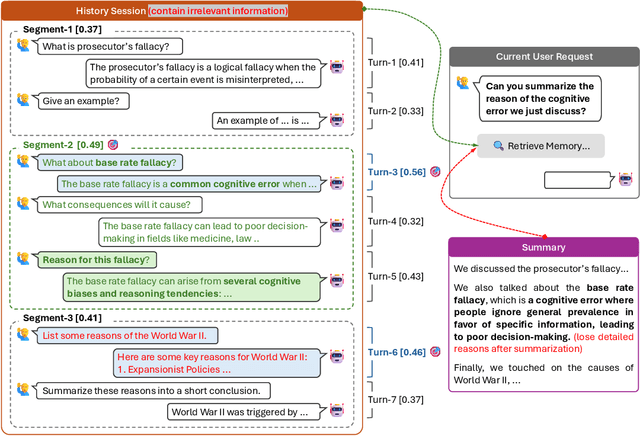
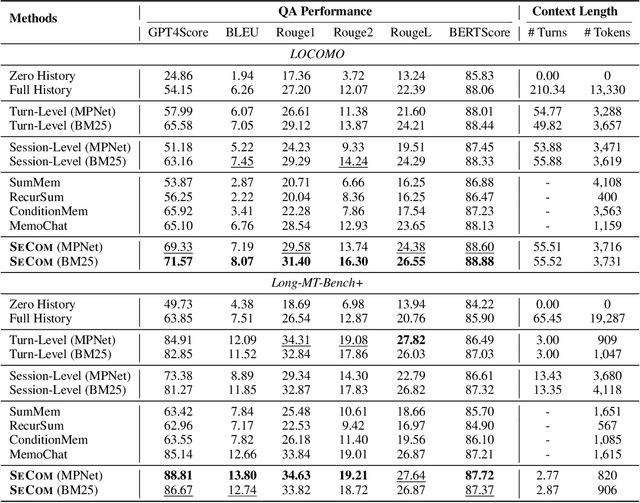


Abstract:To deliver coherent and personalized experiences in long-term conversations, existing approaches typically perform retrieval augmented response generation by constructing memory banks from conversation history at either the turn-level, session-level, or through summarization techniques. In this paper, we present two key findings: (1) The granularity of memory unit matters: Turn-level, session-level, and summarization-based methods each exhibit limitations in both memory retrieval accuracy and the semantic quality of the retrieved content. (2) Prompt compression methods, such as \textit{LLMLingua-2}, can effectively serve as a denoising mechanism, enhancing memory retrieval accuracy across different granularities. Building on these insights, we propose SeCom, a method that constructs a memory bank with topical segments by introducing a conversation Segmentation model, while performing memory retrieval based on Compressed memory units. Experimental results show that SeCom outperforms turn-level, session-level, and several summarization-based methods on long-term conversation benchmarks such as LOCOMO and Long-MT-Bench+. Additionally, the proposed conversation segmentation method demonstrates superior performance on dialogue segmentation datasets such as DialSeg711, TIAGE, and SuperDialSeg.
TokenSelect: Efficient Long-Context Inference and Length Extrapolation for LLMs via Dynamic Token-Level KV Cache Selection
Nov 05, 2024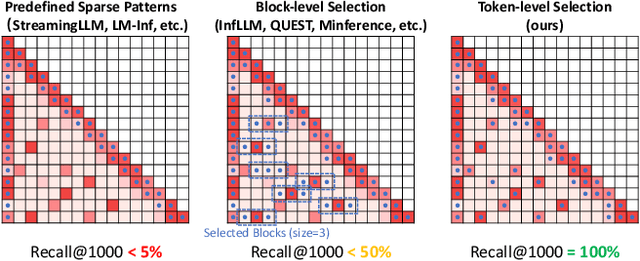
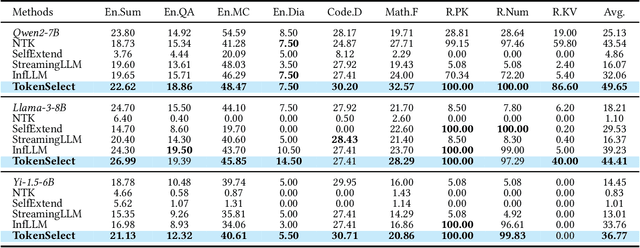

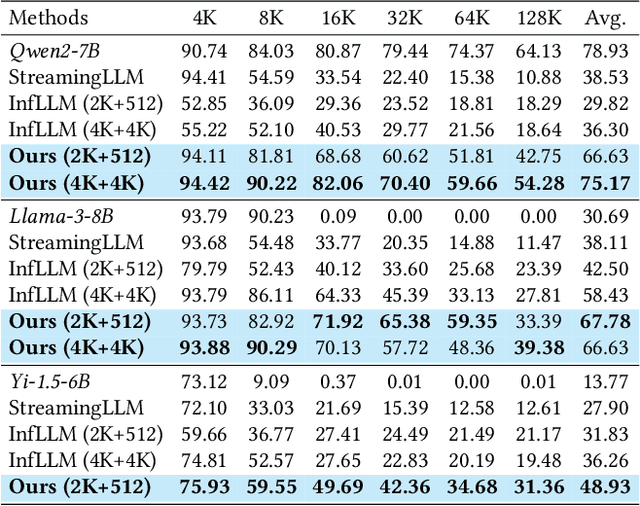
Abstract:With the development of large language models (LLMs), the ability to handle longer contexts has become a key capability for Web applications such as cross-document understanding and LLM-powered search systems. However, this progress faces two major challenges: performance degradation due to sequence lengths out-of-distribution, and excessively long inference times caused by the quadratic computational complexity of attention. These issues hinder the application of LLMs in long-context scenarios. In this paper, we propose Dynamic Token-Level KV Cache Selection (TokenSelect), a model-agnostic, training-free method for efficient and accurate long-context inference. TokenSelect builds upon the observation of non-contiguous attention sparsity, using Query-Key dot products to measure per-head KV Cache criticality at token-level. By per-head soft voting mechanism, TokenSelect selectively involves a small number of critical KV cache tokens in the attention calculation without sacrificing accuracy. To further accelerate TokenSelect, we designed the Selection Cache based on observations of consecutive Query similarity and implemented efficient dot product kernel, significantly reducing the overhead of token selection. A comprehensive evaluation of TokenSelect demonstrates up to 23.84x speedup in attention computation and up to 2.28x acceleration in end-to-end latency, while providing superior performance compared to state-of-the-art long-context inference methods.
LLMLingua-2: Data Distillation for Efficient and Faithful Task-Agnostic Prompt Compression
Mar 19, 2024



Abstract:This paper focuses on task-agnostic prompt compression for better generalizability and efficiency. Considering the redundancy in natural language, existing approaches compress prompts by removing tokens or lexical units according to their information entropy obtained from a causal language model such as LLaMa-7B. The challenge is that information entropy may be a suboptimal compression metric: (i) it only leverages unidirectional context and may fail to capture all essential information needed for prompt compression; (ii) it is not aligned with the prompt compression objective. To address these issues, we propose a data distillation procedure to derive knowledge from an LLM to compress prompts without losing crucial information, and meantime, introduce an extractive text compression dataset. We formulate prompt compression as a token classification problem to guarantee the faithfulness of the compressed prompt to the original one, and use a Transformer encoder as the base architecture to capture all essential information for prompt compression from the full bidirectional context. Our approach leads to lower latency by explicitly learning the compression objective with smaller models such as XLM-RoBERTa-large and mBERT. We evaluate our method on both in-domain and out-of-domain datasets, including MeetingBank, LongBench, ZeroScrolls, GSM8K, and BBH. Despite its small size, our model shows significant performance gains over strong baselines and demonstrates robust generalization ability across different LLMs. Additionally, our model is 3x-6x faster than existing prompt compression methods, while accelerating the end-to-end latency by 1.6x-2.9x with compression ratios of 2x-5x.
 Add to Chrome
Add to Chrome Add to Firefox
Add to Firefox Add to Edge
Add to Edge